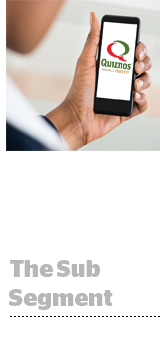 Quiznos is working to connect the dots between digital ad exposures and store visitation.
Quiznos is working to connect the dots between digital ad exposures and store visitation.
After emerging from bankruptcy in 2014, Quiznos reduced its brick-and-mortar presence. With fewer stores, each location had to work harder. So Quiznos changed its media mix to support its new retail footprint.
Although television used to be a focal point for the quick-service sandwich shop, it is investing more in digital and mobile video to capture its core male millennial demographic as that audience departs from traditional TV.
For several years, the brand has experimented with proximity marketing, using Apple’s iBeacon technology to locate consumers and tailor desktop, mobile and video ads to different ZIP codes, based on when a consumer is most likely to eat a Quiznos sub.
More recently, Quiznos sought to determine if those mobile ads had a better chance of generating in-store purchases versus its desktop video and display ads. It wanted to see whether using different ad formats, creative types or no ads at all changed offline foot-traffic patterns.
So Quiznos embarked on a five-month campaign this year, using demand-side platform TubeMogul to target video and display ads to 8.4 million unique devices. It used location data provider NinthDecimal to attribute those ad exposures to in-store lift.“I think our goals remained the same [as our initial location-based campaigns],” said Tim Kraus, Quiznos’ director of interactive and innovation. “We wanted to use data and [third-party] verification to make our buys as efficient as possible.”
Quiznos ran a control test to measure the traffic patterns in 680 nationwide restaurants using Ninth Decimal’s location-tracking technology, Location Conversion Index (LCI).
Because LCI only measured visitation and not the purchase, TubeMogul applied a couple of other data points such as purchase insights to gauge: demonstrable ROI, according to Max Mead, SVP of platform strategy for TubeMogul.
The control test revealed a 29% increase in in-store visits after combined desktop and mobile ad exposures.
Mobile-only ad exposures yielded a 40% lift in in-store visits from consumers on the go. There was a 21% return on overall ad spend.
“We did [this campaign] because we wanted to make sure our [media] was actually driving foot traffic to our stores and incremental visits,” Kraus said. “You don’t want to innovate for the sake of innovating. You have to impact the bottom line.”
Although Quiznos was a relatively early adopter of iBeacons and other proximity marketing tactics, the biggest evolution is the brand’s ability to link the real-time foot traffic/visitation data to other sources – like POS systems, ecom shopping cart abandonment or metrics at the ad server level, like viewability and player size.
“There’s a greater demand for omnichannel [marketing] where people understand that it might take a video ad, display ad, an email, a push notification to actually get the conversion the marketer wants,” Kraus added. “There’s still work to be done, but we’re upgrading our POS system and making sure we have programs to track full lifetime value for end-to-end ROI.”













